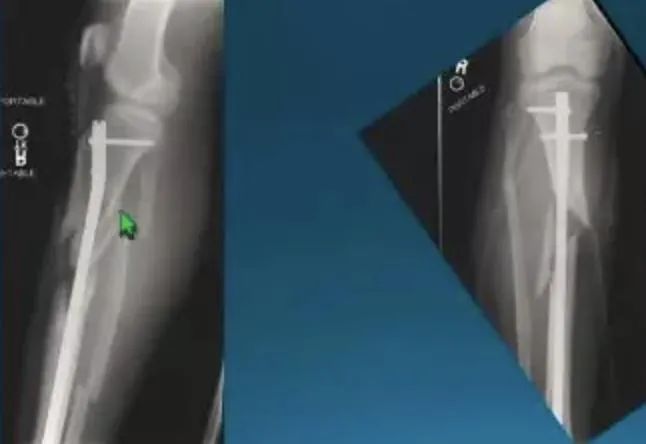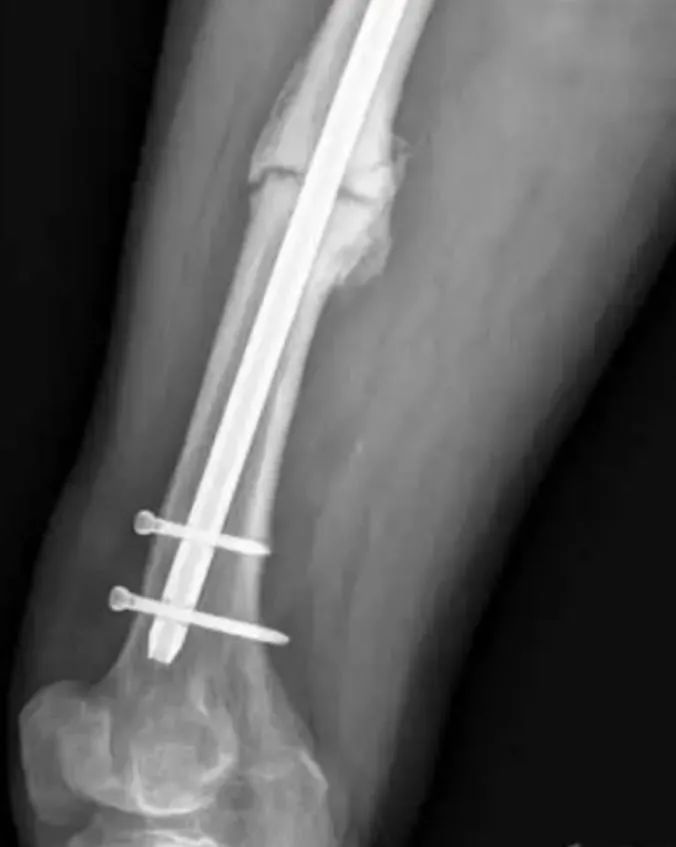Often, the intramedullary nail may need to be removed before a nonunion requires revision surgery. However, once the fracture has healed, the removal of the intramedullary nail has become controversial. Persistent or progressive pain after fracture healing may be an indication for nail removal. Of course, blind removal of internal fixation may not solve or even aggravate the problem until the cause of the pain is identified. The surgeon should carefully consider the presence of the following indications when deciding whether to remove the intramedullary nail.
Chronic pain following intramedullary nail implantation is common in the lower extremities. For example, soft tissue irritation and impingement caused by the protrusion of the tail and the protruding head of the locking nail are a clear source of pain.But, the source of persistent pain after fracture healing remains unknown.
Pain in the greater trochanter is relatively common after anterograde intramedullary nailing, but its exact incidence has not been quantified, and this pain is often not caused by protrusion of the nail tail. Pain in the front of the thigh may be caused by the tip of the intramedullary nail hitting the anterior cortex of the femur. Removal of the femoral intramedullary nail has been reported in the literature to improve pain symptoms, even though in some cases the source of pain has not been identified.
Pain after tibial intramedullary nailing, especially anterior knee pain, is also common. However, whether removal of the intramedullary nail is beneficial for pain relief remains open to question. Pain occurs for many reasons, including disruption of normal anatomical structures (infrapatellar ramus of saphenous nerve, patellar tendon, infrapatellar fat pad, medial meniscus, and tibial plateau or patellar cartilage) during screw insertion. However, all methods aimed at reducing the above injuries still did not reduce the incidence of postoperative anterior knee pain after application. Therefore, before removing the intramedullary nail, the physician should discuss with the patient that the surgical procedure may not relieve pain and create new postoperative complications. Anterior knee pain can also be caused by a protruding spike at the entry point. Arthroscopy confirmed that the protruding pin tail impinged on the articular surface of the femur resulting in cartilage lesions. At the same time, the protrusion of the nail tail can also cause damage to the patellar tendon. An indication for removal of the intramedullary nail exists if symptoms or complications are proven to be caused by a herniated nail tail.

The upper extremity intramedullary nail, if well positioned, usually causes little pain, except for some irritation caused by the protruding part of the internal fixation, which should be considered for removal of the intramedullary nail.
Removing a broken intramedullary nail is challenging. Internal fixation failures are usually fatigue failures due to repeated under-threshold loads. During the secondary healing process of callus formation, the intramedullary nail is stimulated by repeated deformation forces. Compared with the earlier slotted intramedullary nails, the new cross-sectional closed intramedullary nails are more resistant to such deformation forces. Likewise, an increase in diameter can improve the anti-fatigue properties of the intramedullary nail. Once the intramedullary nail is broken, it indicates that there is still movement at the fracture end, so the fracture of the intramedullary nail can be regarded as one of the signs of nonunion; in this case, it is necessary to remove the intramedullary nail for further treatment.

Some physicians believe that the fracture of interlocking screws is a manifestation of "autodynamic" and is conducive to fracture healing. It should be clear, however, that motorization is only effective in the early healing process of simple fractures to increase axial compression of the fracture fragment. In other cases, fracture of interlocking screws remains an indication for revision surgery. At this point, the fracture end should be carefully evaluated and observed.
The incidence of deep infection after intramedullary nailing in closed fractures is low, about 1%. The infection rate after open fractures can be as high as 17%. Deep infections usually require removal of the intramedullary nail. It is beneficial to delay the removal of the intramedullary nail and wait for the fracture to heal. However, infection after intramedullary nailing can significantly prolong fracture healing, sometimes requiring debridement and revision prior to fracture healing. Final thorough debridement should be performed after removal of the intramedullary nail, and reaming may help remove infected tissue.
Nonunion of fracture
Once the diagnosis of nonunion is established, removal of the intramedullary nail should be considered before it ruptures. Determining when an intramedullary nail ruptures is often difficult, so when to remove the intramedullary nail is controversial. However, removal of an intact intramedullary nail is far simpler than removal of a broken intramedullary nail, so the surgeon must take this factor into account in subsequent treatment options.

Subsequent joint replacement surgery
Removing an intramedullary nail after many years can be difficult. Additional manipulations around the joint during joint replacement increase the risk of postoperative infection, and complications from intramedullary nail removal can complicate joint replacement surgery. These factors lead some physicians to believe that all intramedullary nails should be removed once the patient may require subsequent joint replacement surgery. However, this concept is not supported by any literature evidence.
Neither dry fractures nor intramedullary nailing were risk factors for subsequent joint replacement surgery, whereas intra-articular trauma was one of the factors. Patients with inflammatory joint disease may also require subsequent joint replacement therapy. Therefore, in such patients, there may be an indication for routine removal of the accompanying internal nail.
How to Buy Orthopaedic Implants and Orthopaedic Instruments?
For CZMEDITECH, we have a very complete product line of orthopedic surgery implants and corresponding instruments, the products including spine implants, intramedullary nails, trauma plate, locking plate, cranial-maxillofacial, prosthesis, power tools, external fixators, arthroscopy, veterinary care and their supporting instrument sets.
In addition, we are committed to continuously developing new products and expanding product lines, so as to meet the surgical needs of more doctors and patients, and also make our company more competitive in the whole global orthopedic implants and instruments industry.
We export worldwide, so you can contact us at email address song@orthopedic-china.com for a free quote, or send a message on WhatsApp for a quick response +86-18112515727.
If want to know more information,click CZMEDITECH to find more details.
English
Français
Русский
Español
العربية
Português
Deutsch
italiano
日本語
한국어
Nederlands
Tiếng Việt
ไทย
Polski
Türkçe
አማርኛ
ພາສາລາວ
ភាសាខ្មែរ
Bahasa Melayu
ဗမာစာ
தமிழ்
Filipino
Bahasa Indonesia
magyar
Română
Čeština
Монгол
қазақ
Српски
हिन्दी
فارسی
Kiswahili
Slovenčina
Slovenščina
Norsk
Svenska
українська
Ελληνικά
Suomi
Հայերեն
עברית
Latine
Dansk
اردو
Shqip
বাংলা
Hrvatski
Afrikaans
Gaeilge
Eesti keel
Māori
नेपाली
Oʻzbekcha
latviešu
অসমীয়া
Aymara
Azərbaycan dili
Bamanankan
Euskara
Беларуская мова
भोजपुरी
Bosanski
Български
Català
Cebuano
Corsu
ދިވެހި
डोग्रिड ने दी
Esperanto
Eʋegbe
Frysk
Galego
ქართული
guarani
ગુજરાતી
Kreyòl ayisyen
Hausa
ʻŌlelo Hawaiʻi
Hmoob
íslenska
Igbo
Ilocano
Basa Jawa
ಕನ್ನಡ
Kinyarwanda
गोंगेन हें नांव
Krio we dɛn kɔl Krio
Kurdî
Kurdî
Кыргызча
Lingala
Lietuvių
Oluganda
Lëtzebuergesch
Македонски
मैथिली
Malagasy
മലയാളം
Malti
मराठी
ꯃꯦꯇꯥꯏ (ꯃꯅꯤꯄꯨꯔꯤ) ꯴.
Mizo tawng
Chichewa
ଓଡ଼ିଆ
Afaan Oromoo
پښتو
ਪੰਜਾਬੀ
Runasimi
Gagana Samoa
संस्कृत
Gaelo Albannach
Sepeti
Sesotho
chiShona
سنڌي
Soomaali
Basa Sunda
Wikang Tagalog
Тоҷикӣ
Татарча
తెలుగు
ትግንያውያን
Xitsonga
Türkmençe
संस्कृत
ئۇيغۇرچە
Cymraeg
isiXhosa
ייִדיש
Yorùbá
isiZulu













